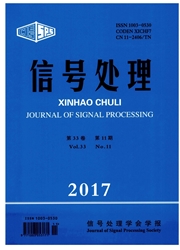

 中文摘要:
中文摘要:
自适应波束形成(adaptive beam-forming:ABF)方法通过对阵列数据进行加权处理来获得最大的输出信干噪比,对采样协方差矩阵依赖性较大。在小快拍和通道随机响应误差条件下,采样协方差矩阵的估计值与真实值通常存在较大差异,严重恶化了基于线性约束最小均方误差准则的自适应波束形成方法的干扰抑制性能。针对该问题,本文基于子空间投影类波束形成方法的思想,提出采用迭代子空间跟踪和结构约束的自适应波束形成方法。该方法首先利用clearing技术在训练样本集上依次跟踪主特征矢量并构成信号子空间;然后根据子空间投影类波束形成权矢量的结构特性计算自适应加权矢量。仿真结果表明本文方法能有效提高自适应波束算法的输出信干噪比。
 英文摘要:
英文摘要:
The maximum output signal to interference plus noise ration (SINR) can be achieved as weighted the array da- ta's by adopting adaptive beam-forming (ABF) algorithm. Therefore, the deviation between the estimated sample matrix and the ideally correlation matrix will deteriorate the performance of the linearly constrained minimum variance (LCMV) beam-former. To alleviate this decreasing in output SINR with secondary data deficient scenario and channel mismatch coex- istence, a new method based on iterative subspace tracking and structural constraint is presented. The approach is per- formed in two stages. First, we employ clearing operation at training data set to calculate each principal eigenveetor in se- quentially, then, the adaptive beam-forming algorithm based on subspace projection can be obtained by constraining its weight vector to a specific form. The high output signal to interference plus noise ration of subspace processing is remained and the robustness against small sample support and in the presence of channel mismatch is improved. Numerical simulation indicate that its performance is better than that of several well-known adaptive beam-former.
 同期刊论文项目
同期刊论文项目
 同项目期刊论文
同项目期刊论文
 A Modified Fast Approximated Power Iteration Subspace Tracking Method for Space-Time Adaptive Proces
A Modified Fast Approximated Power Iteration Subspace Tracking Method for Space-Time Adaptive Proces Airborne GMTI experiment based on multi-channel synthetic aperture radar using space time adaptive p
Airborne GMTI experiment based on multi-channel synthetic aperture radar using space time adaptive p Performance improvement for monostatic clutter mitigation using space-time-range three-dimensional a
Performance improvement for monostatic clutter mitigation using space-time-range three-dimensional a 期刊信息
期刊信息
